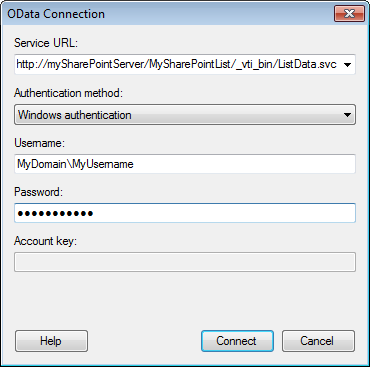
OData (Open Data Protocol) is a standard for providing data as a web service. The dialog below is used to set up a connection to data in any web service complying with the OData standard. For example, you can access data on SharePoint and Microsoft Azure Marketplace. When connecting to data using the OData connector, only in-memory data analysis is supported. To learn more about OData in general, see the official OData documentation.
You do not have to install a driver on your computer to get access to the OData connector. See Getting Started with Connectors if you need help accessing the connector.
To add a new OData connection to the library:
Select Tools > Manage Data Connections.
Click Add New > Data Connection and select OData.
To add a new OData connection to an analysis:
Select File > Add Data Tables....
Click Add.
Select Connection To > OData.

Option |
Description |
Service
URL |
The address to the web service. For example, to a SharePoint server, or to Azure Marketplace. See Finding the Service URL if you are unsure how to locate the URL to use when loading your data from Azure Marketplace. See Modifying the SharePoint URL to learn how to construct the URL when loading data from SharePoint. |
Authentication
method |
The authentication method to use when connecting to the data source. None Select this option if no authentication is needed when logging into the data source. Username and password Select this option if the authentication should be done using a database user. Database credentials can be stored, unencrypted, as part of the analysis file, using a setting in the Data Source Settings dialog. If credentials are found in the analysis file they will be used to automatically authenticate against the database. If no credentials or credentials profiles are found in the analysis file, all who open the file will be prompted for database credentials. Note that there will be no prompting for credentials if the credentials embedded in the analysis file fail. Windows authentication When using Windows authentication, for example Kerberos, the access token of the logged in user will be used. Users that have been given the appropriate access rights to the data source will be able to connect and read data. Domain credentials are not stored in the analysis file. Example of a username including domain: Microsoft Azure Marketplace Use this option to connect using a Microsoft Azure Marketplace account. See Loading Data from Microsoft Azure Marketplace to learn more. |
Username |
The username you wish to use when logging into the data source. If you are logging in using Windows authentication, your username will be added automatically. To include domain when providing your username, use backslash as separator: domain\username. |
Password |
The password for the specified username. |
Account
key |
[Only applicable when using Microsoft Azure Marketplace authentication.] Paste your Microsoft Azure Account key into the text field. If you are unsure where to find you account key, see Finding your Account Key. |
See also:
Loading Data from Microsoft Azure Marketplace
Loading List Data from SharePoint